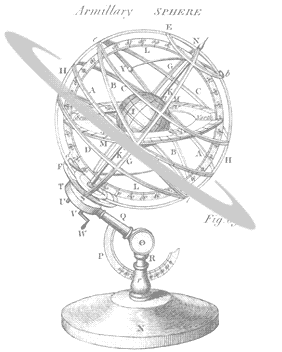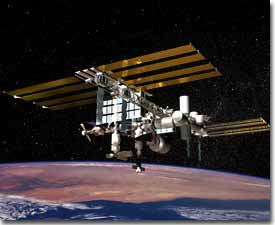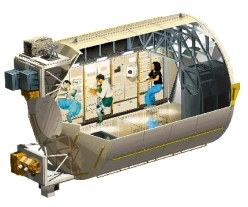|
"Knowledge
comes from the stars."
Bernd Schneider - Ex Astris Scientia - 1998
D
deep
space one
G
galileo
H
human (space) flight
I
international
space station M
mir -----
deep space one
With the
beginning of this millennium, NASA envisions an ambitious space
exploration program through which we can push back the frontiers
of the universe.
Undertaking
this vision is a challenge for engineers who must develop and
design the extraordinary spacecraft of the future. Deep Space One,
launched on october 24, 1998, was the first in a series of deep
space and earth orbiting missions that the New Millennium
Program is conducting to demonstrate new technologies in the
environment of space.
During a highly
successful primary mission, Deep Space One tested twelve
advanced, high-risk technologies in space, including
ionpropulsion and a autonomous self-thinking computer, the
autonav.
Ionpropulsion
was the most challenging new technology. Ionpropulsion was
first designed by the nazi's during the second worldwar. Later,
a group of German scientists who once worked for the nazi's,
started to research the reliability of ionpropulsion. They
decided that this kind of propulsion wasn't reliable for that
time.
----------
The scientists
who worked on the Deep Space One project, however, where of
opinion that the time was here for ionpropulsion. Ionpropulsion
replaces the old chemical rocket engines. Ionpropulsion is more
efficient, faster and it can be used for longer distances.
galileo galilei
Galileo
Galilei was born in Pisa, Italy, in 1564, the same year William
Shakespeare was born and the year that Michelangelo died.
Galileo was home schooled by his father, a nobleman well known
for his musical studies. At the age of 11, Galileo was sent to
the Benedictine Monastery of Santa Maria di Vallombrosa where
he, like other children of the nobility, studied Latin, Greek,
religion, and music. It was when he entered the University of
Pisa in 1581 that Galileo began to question Aristotle's
teachings, particularly his theory of falling objects. Aristotle
proposed that objects of differing weights fall at different
rates of speed. Galileo noticed, while on a walk, that
hailstones appeared to hit the ground at the same time
regardless of their size. His famous experiment dropping
different size balls from the Leaning Tower of Pisa resulted in
new ideas about physics and the idea that "laws" of
science could, and should, be questioned. The image of Galileo
standing atop the Leaning Tower and dropping objects is one that
is common to many textbooks and science resource books because
it symbolizes a turning point in science as a vehicle of
inquiry.
Galileo's many
and varied accomplishments span the scientific disciplines of
astronomy, physics, and optics. He was also an inventor,
mathematician, and author. After an unsuccessful time at the
university, Galileo left formal education to study mathematics
and physics on his own. By the 1580s, he became a Professor of
Mathematics at the University of Pisa and then later at the
University of Padua. He remained in Padua until 1610 where he
spent time experimenting, studying, and inventing. By 1632, he
had invented a geometrical and military compass, built a
thermoscope, patented a machine to raise water levels, invented
a tripod microscope, built a telescope, and wrote the
controversial "Dialogue on the Two Chief World
Systems". Of the telescope, he said:
"A report
reached my ears that a certain Fleming had constructed a
spyglass.... Upon hearing the news, I set myself to thinking
about the problem.... Finally, sparing neither labor nor
expense, I succeeded in constructing for myself so excellent an
instrument that objects seen by means of it appeared nearly one
thousand times larger and over thirty times closer than when
regarded with our natural vision."
This new
instrument, the telescope (a word that was not used until 1611),
would be the instrument of both Galileo's fame and his exile and
imprisonment. While gazing through the telescope, Galileo
observed and drew what he saw: the moon's phases, the Milky Way,
clusters of stars, and phenomena that seemed to confirm his idea
that the Earth was not the center of the universe. Contrary to
the popular Ptolemaic system, Galileo hypothesized that the
Earth was one of many heavenly bodies that comprise our solar
system.
Galileo's views
were not readily accepted by the Church and he was called before
the Pope to account for his dissident views. Asked to give up
the very ideas that he could support through his own
observations, Galileo refused and was exiled in Siena. At the
age of 69, Galileo was allowed to return to his home. Over the
next several years, his health declined and he became totally
blind. His only source of help, his daughter Sister Marie
Celeste, died in 1634. In 1642, the year in which Isaac Newton
was born, Galileo died at his home.
Although
Galileo is remembered for both his experiments with gravity and
for his astronomical observations, his invention of the
telescope is probably his most significant contribution. Other
significant areas of Galileo's influence include mechanics,
microscopy, and magnetism.
international space station
The
International Space Station is the largest and most complex
international scientific project in history. And when it is
complete just after the turn of the century, the station will
represent a move of unprecedented scale off the home planet. Led
by the United States, the International Space Station draws upon
the scientific and technological resources of 16 nations:
Canada, Japan, Russia, 11 nations of the European Space Agency
and Brazil.
----------- -
-
More than four times as large as the Russian Mir space station,
the completed International Space Station will have a mass of
about 1,040,000 pounds. It will measure 356 feet across and 290
feet long, with almost an acre of solar panels to provide
electrical power to six state-of-the-art laboratories.
The station
will be in an orbit with an altitude of 250 statute miles with
an inclination of 51.6 degrees. This orbit allows the station to
be reached by the launch vehicles of all the international
partners to provide a robust capability for the delivery of
crews and supplies. The orbit also provides excellent Earth
observations with coverage of 85 percent of the globe and over
flight of 95 percent of the population. By the end of this year,
about 500,000 pounds of station components will be have been
built at factories around the world.
columbus module
The science module Columbus is ESA's biggest
single contribution to the International Space Station.
Currently scheduled to launch late in 2004, the 4.5-metre
cylindrical module will give an enormous boost to the station's
research capabilities. During its 10-year projected lifespan,
Earth-based researchers, sometimes with a little help from the
ISS crew, will be able to conduct thousands of experiments in
life sciences, materials science, fluid physics and a whole host
of other disciplines, all in the weightlessness of orbit.
To keep costs
low and reliability high, Columbus shares its basic structure
and life-support systems with the Italian Space Agency's
Multi-Purpose Logistics Modules (MPLM). But whereas the MPLM is
aptly described as a 'space moving van' the 75 cubic metres of
space inside Columbus contains an entire suite of science
laboratories. The module has room for 10 International Standard
Payload Racks, each hosting an entire laboratory in miniature,
complete with power and cooling systems, and video and data
links to researchers back on Earth.
----------
Columbus in
orbit is only the most obvious and impressive part of the whole
research programme. Columbus on the ground will involve
researchers all over Europe, who will be able to control their
own experiments directly from several User Centres or even
directly from their workplaces. Their efforts will be channelled
through the Columbus Control Centre in Germany, which will
interface with the module itself and also ESA's NASA partners in
the United States.
Like the
Genoese navigator for whom it was named, Columbus is set for a
long journey of exploration. But thanks to broadband
telecommunications, hundreds, perhaps thousands, of explorers
will be able to work aboard during its 10-year mission.
mir
Russia's
Mir Space Station has been in orbit for over 10 years. The first
element of the station was launched on February 20, 1986 at an
inclination of 51.6 degrees. The current Mir Space Station is
actually a complex of different modules that have been pieced
together.
The Mir module,
the first module of the complex placed in orbit, is the main
module of the station. It provides docking ports for the other
modules to attach to. There are five docking ports on the
transfer compartment of the Mir module. One along the long axis
of the module, and 4 along the radius in 90 degree increments.
There is another docking port on the aft end of the Mir module.
The various modules that are attached to the docking ports can
be moved around to different configurations.
The Soyuz-TM
spacecraft is used to transport crews and cargo to and from the
Mir Space Station. The Soyuz can dock on the axial docking port
on the transfer compartment.
----------
The Progress-M
spacecraft is a cargo and resupply vehicle used to send science
equipment and data to and from Mir. It can also be used to
conduct experiments either while attached to the complex, or
during free-flight. When sent back to Earth, it can also be used
to remove waste materials from the Space Station.
The Mir space
station was taken out of service in february 2000. The space
station crashed into the Pacific Ocean.
|

